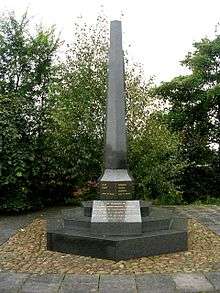Lofthouse Colliery disaster
Coordinates: 53°42′54″N 1°30′18″W / 53.715°N 1.505°W

The Lofthouse Colliery disaster was a mining accident which took place in the West Riding of Yorkshire, England on Wednesday 21 March 1973, in which seven mine workers died when workings were flooded.[1]
Disaster
Lofthouse Colliery was in Lofthouse Gate close to Outwood in the Stanley Urban District where many of the colliers lived. Its site is now in the City of Wakefield. (Lofthouse is further north in the City of Leeds). A new coalface was excavated too close to an abandoned, flooded 19th century mineshaft.[2] The sudden inrush of three million gallons of water[3] trapped seven mine workers 750 feet (228.6 metres) below ground.[4] A six-day rescue operation was carried out but succeeded in recovering only one body, that of Charles Cotton.[5] The location of the flooded shaft was known to National Coal Board (NCB) surveyors but they had not believed it to be as deep as the modern workings. Existing British Geological Survey records indicated that the flooded shaft did descend to the same depth but these records had not been checked by the NCB.[6]
Legacy
The incident led to the Mines (Precautions Against Inrushes) Regulations 1979 ("PAIR"), requiring "examination of records held by the Natural Environment Research Council which might be relevant to proposed workings [and] diligent enquiry into other sources of information which may be available, e.g. from geological memoirs, archives, libraries and persons with knowledge of the area and its history".[7]
The response of Arthur Scargill, then working as a compensation agent in the Yorkshire NUM, is credited with boosting his popularity with the Yorkshire miners and helping his election to the post of president of the Yorkshire Area NUM later in 1973.[8][9] He accompanied the rescue teams underground and was on site for six days with the relatives of the ten deceased.[8] At the subsequent enquiry, he used notebooks of underground working from the 19th century, retrieved from the Institute of Geological Sciences in Leeds, to argue that the National Coal Board could have prevented the disaster had they acted on the information available.[8]
Lofthouse Colliery subsequently closed in 1981, with many of the miners being transferred to the new Selby Coalfield.[10]
Memorial
A seven-sided stone obelisk listing the names of the seven miners was erected in Wrenthorpe above the point where the miners were trapped. It is on the south side of Batley Road, opposite the junction with Wrenthorpe Lane (grid reference SE303221).
The men who died were:
- Frederick Armitage, 41
- Colin Barnaby, 36
- Frank Billingham, 48
- Sydney Brown, 36
- Charles Cotton, 49 (the only miner whose body was recovered)[3]
- Edward Finnegan, 40
- Alan Haigh, 30
Services and reunions were held in Wakefield and Wrenthorpe on the weekend of 23/24 March 2013, to commemorate the 40th anniversary of the disaster.[3]
See also
References
- ↑ "The Lofthouse Colliery Disaster". BBC. January 2003. Retrieved 28 July 2011.
- ↑ Price, Michael (1996). Introducing Groundwater. Routledge. p. 223. ISBN 978-0-7487-4371-1.
- 1 2 3 "Lofthouse Colliery miners remembered at services". BBC News. Retrieved 14 December 2014.
- ↑ Faux, Ronald (23 March 1973). "Mine rescue hopes set back six hours". The Times (58739). London. p. 1.
- ↑ "New video's tribute to miners in pit tragedy". Yorkshire Evening Post. 4 October 2001. Retrieved 28 July 2011.
- ↑ Younger, P.L.; Adams, R. (1999). Predicting Mine Water Rebound. Bristol: Environment Agency. p. 39. ISBN 1-85705-050-9.
- ↑ The prevention of inrushes in mines: Approved Code of Practice. Health and Safety Executive. 1993. pp. 17–18. ISBN 978-0-7176-0620-7.
- 1 2 3 Routledge, Paul (1994). Scargill: the unauthorized biography. London: Harper Collins. p. 58. ISBN 0-00-638077-8.
- ↑ Strike: 358 Days that Shook the Nation. London: Sunday Times. p. 13. ISBN 0-340-38445-X.
- ↑ BBC Bradford & West Yorkshire - 'It was never the same again!'